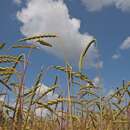Brief Summary
provided by EOL authors
Triticum spelta, spelt, which is sometimes classified as a variety of common wheat, T. aestivum var. spelta, is an annual grass in the Poaceae (grass family) native to the Mediterranean region and southwest Asia. Spelt is one of several species and numerous varieties of cultivated wheat, which was an important grain in Europe from the Bronze Age until medieval period, when it was largely replaced by other forms of wheat (T. aestivum and T. durum, durum wheat), although it continued to be commonly used in Central Europe through the 1800s and early 1900s, and cultivated in the Mediterranean. It has received renewed attention in the past two decades due to the organic farming movement (because it requires less fertilizer and fewer pesticides than other forms of wheat) and as a health food (because it is tolerated by some people who are allergic to common wheat). Wheat is one of the most ancient of domesticated crops. Archaeological evidence of cultivated spelt has been found in the Transcaucasus region, northeast of the Black Sea, dating back to 5,000 B.C. The various species of wheat have been developed into thousands of hybrids and cultivars, including spelt, that differ in chromosome number from the primitive diploid types, which had 7 pairs of chromosomes, to various hybrid allopolyploids, with 14, 21, and 28 chromosome pairs. Spelt is a tetraploid (with 28 chromosome pairs) thought to have originated as a cross between emmer wheat (T. turgidum) and the wild goat-grass, Aegilops tauschii, possibly followed by a later cross with T. aestivum. Spelt has slender, loose spikes (grain heads), 12.5 to 20.5 cm (5 to 8 in) long. Each spikelet contains two grains, which remain enclosed in the glumes or husks after threshing (in contrast to T. aestivum, which is known as free-threshing because the grains separate easily from the husks). Spelt is very hardy and can tolerate nutrient-poor soils. Spelt is similar to other forms of wheat in its nutrient profiled--high in carbohydrates, protein, and vitamins B and E (if the grain is left whole)—but it is generally higher in B vitamins and protein, and lower in the amino acid lysine. Spelt, which has a nutty flavor, contains less gluten than common wheat, but contains enough that it is used similarly to common wheat in bread, baked goods, and breakfast cereals. It is also used like durum wheat (T. durum) to make pasta. Spelt is also rolled and sold as flakes (similar to oats) for use as a cereal. In addition it its use as a human food, spelt is sometimes cultivated as livestock feed and fodder. Spelt was brought to the U.S. in the late 1800s, and production peaked in during the early 1900s, when it was replaced by higher yielding, more productive, and easier to thresh grains including common wheat, oats (Avena sativa), and barley (Hordeum vulgare). U.S. production was revived in the 1980s by a health food company based in Michigan. (Bailey et al. 1976, Boland 2011, Hedrick 1919, USDA 2012, Stallknecht et al. 1996, University of Kentucky Extension 2000, van Wyk 2005.)

